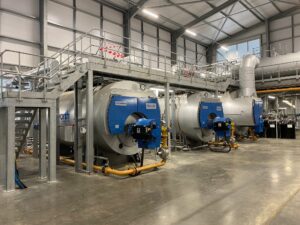Life Sciences
Environmental sustainability in pharmaceutical manufacturing 17th August 2021
By Brian Peutherer, HSE Director at Sterling Pharma Solutions, Dudley, UK

Manufacturing active pharmaceutical ingredients (APIs) relies often on energy-intensive processes and can generate large volumes of waste materials. Manufacturers are constantly looking for ways to make processes more efficient, and the need for sustainability in terms of energy use and waste management are key aspects within this. In this article, Brian Peutherer of Sterling Pharma Solutions discusses some of the considerations API manufacturers take into account when assessing the sustainability of facilities and processes, and highlights some of the commitments and investments that Sterling has made to its site in Dudley, UK.
 While the pharmaceutical industry has always been highly regulated, its impact on sustainability has been less so. cGMP regulations ensure product and process quality and safety, but they do not account for pollution.1In 2020, CPhI called on pharmaceutical organizations to prioritize environmental sustainability,2and the global focus on fighting climate change has led pharmaceutical service providers to formalize their sustainability efforts alongside a drive towards greater efficiency. These efforts have increasingly seen sponsors prioritizing sustainability among their decision criteria when evaluating potential development partners.
While the pharmaceutical industry has always been highly regulated, its impact on sustainability has been less so. cGMP regulations ensure product and process quality and safety, but they do not account for pollution.1In 2020, CPhI called on pharmaceutical organizations to prioritize environmental sustainability,2and the global focus on fighting climate change has led pharmaceutical service providers to formalize their sustainability efforts alongside a drive towards greater efficiency. These efforts have increasingly seen sponsors prioritizing sustainability among their decision criteria when evaluating potential development partners.
There are many considerations when assessing the sustainability of companies, with four of the key areas being energy usage, daily processes, waste management, and continual improvement. However, it is important to remember that environmental sustainability cannot be achieved solely through isolated initiatives: it requires planning, continual investment, and a cohesive, company-wide commitment.
Energy
Pharmaceutical development and manufacturing require a massive amount of energy to produce a comparatively small amount of active pharmaceutical ingredient (API), with the average pharmaceutical plant having an energy usage intensity (EUI) nearly 15 times greater than the average office building.3
Whereas the total usage may be difficult to change, as energy is needed for a broad range of activities, from powering core equipment and systems to maintaining facility-wide lighting and ventilation, the source of the energy a plant uses can be improved: for example, by reducing the energy drawn from the national grid and working towards self-sufficiency, and through the use of renewable energy sources. Energy efficiency not only benefits the environment by reducing greenhouse gas emissions but can also help to reduce operational costs.
Daily processes
Green chemistry, which is the design of chemical products and processes that reduce or eliminate the use or generation of hazardous substances, includes 12 key principles in alignment with environmental sustainability, including waste prevention, safer solvents, and energy efficiency.4Companies can look to adopt innovative manufacturing technologies to create more efficient processes, as well as choose alternative solvents that have less environmental impact.
Waste management
Waste is an unfortunate by-product of any drug’s lifecycle, and pharmaceutical manufacturing generates more waste per measure of product than any other sector within the chemical industry.5However, waste hierarchy measures can be taken to properly manage harmful waste, so designing a process to reduce the waste output produced from it should be a commitment from manufacturers.
Solvents are one of the greatest sources of waste, and companies can look to recover and recycle these, as well as put measures in place to treat solvents prior to disposal. Water treatment facilities can also greatly improve environmental impact, and where any waste is created, methods of recycling or reuse, instead of landfill or incineration, should be considered.
Continual improvement
In a poll published in 2021, 43% of pharmaceutical professionals cited environmental sustainability as the area of environmental, social, and governance(ESG) criteria that needs to be most urgently addressed.6 It is important for companies to think not only about what it can do now with regards to sustainability, but to have plans in place for ongoing progress, with clearly defined sustainability objectives.
These plans will involve investments in sustainability-related enhancements to facilities and processes, but also in implementing a culture of continual improvement, education, and empowerment of employees.
Sterling Pharma Solutions’ commitment to sustainability
Sterling is committed to being as environmentally sustainable as it can be and has created a global roadmap that balances small- and large-scale sustainability initiatives throughout every part of its global operation. Its Northumberland, UK site is leading the way, with a view to using similar strategies in as many of its other global facilities as is practical.
There is an absolute vision within the company to achieve complete carbon neutrality, however, this long-term strategy is backed up by step-wise progression, the first of which is to reduce energy-related emissions by 50% by 2025.
An on-site combined heat and power plant at Northumberland makes the site self-sufficient in electricity; removing the need to purchase electricity from the national grid and therefore improving generation efficiency. Energy-efficient lighting has been installed throughout the facility, and the construction of an anaerobic digestion plant is underway, which will convert waste into a usable energy source to supply back into the national grid, with the aim of reducing waste treatment emissions by 65%.
Additionally, the site has pressure swing absorption (PSA)bulk nitrogen systems that improve self-sufficiency by selectively drawing nitrogen from the atmosphere and reducing transportation-related emissions. To promote biodiversity, there are established designated wetlands, a wildlife reserve, and areas of woodland, hedgerow, and flower meadow.
From a scientific and process standpoint, Sterling works closely with its customers to match their sustainability goals and looks for opportunities to embrace greener practices wherever possible. This means processes are actively reviewed to assess whether alternative solvents can be used that have less environmental impact, whether process materials can be recycled, or whether technologies such as biocatalysis, which adheres to several green chemistry principles, can be incorporated into manufacturing.
Most importantly, Sterling has positioned its commitment to sustainability as core to its organizational culture. The company has pledged to be transparent about its current environmental burdens and future objectives, and all its employees are focused on short-term and long-term goals to improve sustainability, as well as being encouraged to identify new ways to enhance environmental sustainability.
References
- S. Milmo, “Pharmaceutical Environmental Pollution and Antimicrobial Resistance,”Pharmaceutical Technology Europe 29 (10) 6–8 (2017).
- https://www.biopharma-reporter.com/Article/2020/09/30/CPhI-calls-on-pharma-companies-to-put-sustainability-at-the-top-of-their-agenda
- Caparella, J. Energy Benchmarking in the Pharmaceutical Industry. Pharm. Eng. [Online] 2013, 33, https://ipsdb.com/files/docs/13SO-Capparella.pdf
- https://www.acs.org/content/acs/en/greenchemistry/principles/12-principles-of-green-chemistry.html
- Berkeley W. Cue & Ji Zhang (2009) Green process chemistry in the pharmaceutical industry, Green Chemistry Letters and Reviews, 2:4, 193-211, DOI: 10.1080/17518250903258150
- https://www.pharmaceutical-technology.com/news/environmental-sustainability-in-the-pharmaceutical-industry-needs-to-be-addressed-the-most-poll/


